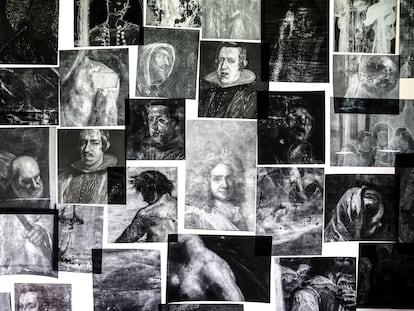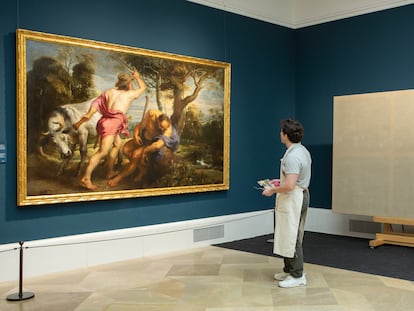Spain’s Prado Museum beautifully restores a beloved Caravaggio
After a three-month restoration, ‘David with the Head of Goliath’ is now back on display

David with the Head of Goliath, an oil painting by the Italian master Caravaggio, is an old friend who lives at the Prado Museum in Madrid. In Spain, there are only four artworks by the Baroque genius whose life of crime led to public condemnation of his work. As a result, many of his paintings were lost and occasionally resurface in unexpected places centuries later. On December 19, the Prado unveiled a new restoration of its prized Caravaggio that David García Cueto, (Head of the Department of Italian and French Painting up to 1800) says reclaims the artist’s original vision.
The museum has acknowledged that the painting has been in need of restoration for years. It was exhibited in the Prado’s Guido Reni exhibition last April, where several experts expressed the same opinion. However, the restoration work didn’t begin until the end of September. In the past three months, Almudena Sánchez has undertaken the challenging task that led to this week’s presentation of the restored work in the Prado’s last exhibition of the year. The restoration adds to the excitement and intrigue surrounding Caravaggio, especially given the highly anticipated exhibition of the so-called “2021 Caravaggio″ discovered two years ago..
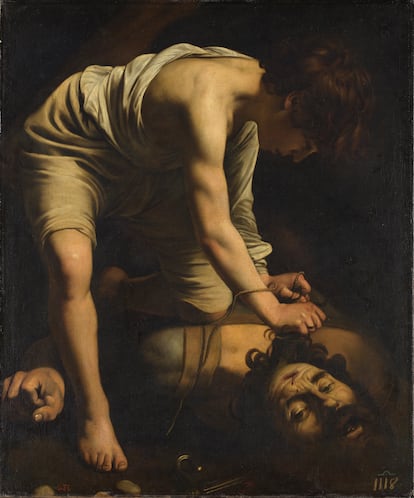
The “2021 Caravaggio” is a small oil painting that avoided being sold at a Madrid auction for €1,500 in 2021 after experts suggested it could be the work of the Italian master Michelangelo Merisi da Caravaggio. The Ecce homo (the scourged Christ) painting caused such a stir in the art world that the Ministry of Culture had to intervene to stop the sale and protect the piece. Since then, the painting has been hidden away in a warehouse for more than two years. Despite all the intrigue, the Prado has accepted its attribution to Caravaggio, although only one scientific study has been published so far. “There are four Caravaggios in Spain,” said García and Prado Museum Director Miguel Falomir. The Prado has David with the Head of Goliath; the Royal Collections Gallery has Salomé; the Montserrat Museum has Saint Jerome in Meditation; and the Pérez de Castro family owns Ecce homo. “There is consensus in the scientific community [about Ecce homo], which is unusual among Caravaggio scholars who tend to argue a lot.”
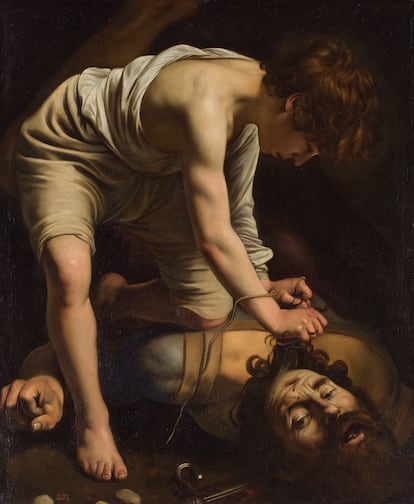
Only time will tell if Ecce homo will end up in room 7A of the Prado where David with the Head of Goliath now hangs in all its splendor. In her restoration, Sánchez removed layers of dirt and yellowed varnishes that “had erased the piece’s depth of field.” Before the restoration, two brightly lit figures overlaid a dark background. Now, viewers can more easily distinguish several planes in the painting. Sánchez successfully highlighted Goliath’s foreshortened body, depicting how he fell face-first to the ground after David struck him with a rock and then finished him off with his sword. “Now you can see his buttocks and leg extending behind David,” said Sánchez.
El Museo del Prado expone el magnífico "David vencedor de Goliat" de Caravaggio tras una restauración que recupera el claroscuro original y elementos ocultos https://t.co/C09vDvcaKU pic.twitter.com/MomEQOEWc3
— Museo del Prado (@museodelprado) December 19, 2023
The painting had been x-rayed before, but with new technology, we gained a clearer understanding of Caravaggio’s artistic process. The artist initially painted Goliath’s face with bulging eyes and a wide-open mouth, creating a dramatic effect. “He [Goliath] was dying but still alive,” said García. “Then he [Carvaggio] painted a slightly less agonized expression over it.” These details can be seen in Goliath’s eyelids and the irises of his eyes.
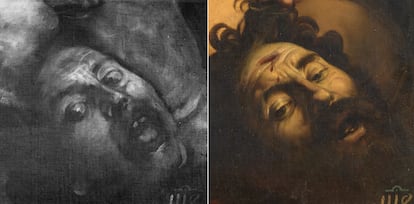
Caravaggio’s depiction of David in this painting (circa 1600) marked a shift in how this Biblical character was portrayed in art, and influenced later artistic trends and artists. As an example, García cites Orazio Gentileschi’s David Contemplating the Head of Goliath (circa 1610). Although there are only four Caravaggios in Spanish collections, García says “all are of exceptional quality.”
Sign up for our weekly newsletter to get more English-language news coverage from EL PAÍS USA Edition
Tu suscripción se está usando en otro dispositivo
¿Quieres añadir otro usuario a tu suscripción?
Si continúas leyendo en este dispositivo, no se podrá leer en el otro.
FlechaTu suscripción se está usando en otro dispositivo y solo puedes acceder a EL PAÍS desde un dispositivo a la vez.
Si quieres compartir tu cuenta, cambia tu suscripción a la modalidad Premium, así podrás añadir otro usuario. Cada uno accederá con su propia cuenta de email, lo que os permitirá personalizar vuestra experiencia en EL PAÍS.
¿Tienes una suscripción de empresa? Accede aquí para contratar más cuentas.
En el caso de no saber quién está usando tu cuenta, te recomendamos cambiar tu contraseña aquí.
Si decides continuar compartiendo tu cuenta, este mensaje se mostrará en tu dispositivo y en el de la otra persona que está usando tu cuenta de forma indefinida, afectando a tu experiencia de lectura. Puedes consultar aquí los términos y condiciones de la suscripción digital.
More information
Archived In
Últimas noticias
Maduro pleads not guilty before the federal court in New York: ‘I am still the president of Venezuela’
A new test can detect Alzheimer’s from a finger prick
UN team enters Sudanese city of El Fasher after paramilitary massacre: ‘It’s like a ghost town’
A recipe for resistance: Indigenous peoples politicize their struggles from the kitchen
Most viewed
- Gilles Lipovetsky: ‘If you want to live better and fall in love, take Prozac, don’t look to philosophy’
- Alain Aspect, Nobel laureate in physics: ‘Einstein was so smart that he would have had to recognize quantum entanglement’
- Alvin Hellerstein, a 92-year-old judge appointed by Bill Clinton, to preside over Maduro’s trial in New York
- Why oil has been at the center of Venezuela-US conflicts for decades
- Maduro’s downfall puts China’s relationship with Venezuela to the test

